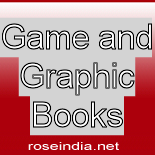Game and Graphic Books
-
Computer Game Developer
I've always thought game developers were born, not made. True greatness comes from within. If it isn't there, it can't be learned, and if it is there, it can't help but be discovered. To be a game developer, you must truly love games. Not just playing games, but understanding games. You must love the whole concept of dissecting a game, breaking it down to its smallest parts, and visualizing how the pieces fit into the whole. The chapters in this web site deal with the programming aspects of game development. It should be noted, there are other careers in game development besides that of programmer. A typical game passes through many hands on its way to final release.
-
OpenGL Programming Guide
The OpenGL graphics system is a software interface to graphics hardware. (The GL stands for Graphics Library.) It allows you to create interactive programs that produce color images of moving three-dimensional objects. With OpenGL, you can control computer-graphics technology to produce realistic pictures or ones that depart from reality in imaginative ways. This guide explains how to program with the OpenGL graphics system to deliver the visual effect you want.
-
Graphic Programming Black Books
Michael Abrash's classic Graphics Programming Black Book is a compilation of Michael's previous writings on assembly language and graphics programming (including from his "Graphics Programming" column in Dr. Dobb's Journal). Much of the focus of this book is on profiling and code testing, as well as performance optimization. It also explores much of the technology behind the Doom and Quake 3-D games, and 3-D graphics problems such as texture mapping, hidden surface removal, and the like. Thanks to Michael for making this book available. The full text of the book is available here in PDF format. Due to the book's length, we've made each chapter available separately. The files are large, so we don't recommend reading them online. We suggest downloading them first (right-click on the link). You may want to start by downloading the Cover, Table of Contents, Introduction, Part 1 Opening Page, and Part 2 Opening Page. Then download any chapters you want.
-
The Art of Computer Game Design
I am deeply indebted to Madeleine M. Gross for her painstaking and thorough criticisms of this book. In many cases she invested greater efforts into her criticisms than I had put into my original thoughts. She strove to restrain my wild hyperbole and place my arguments on a firmer foundation of rigorous logic. The logical consistency and reliability in this book I owe to her; the speculative flights of fancy must be laid at my doorstep. The central premise of this book is that computer games constitute a new and as yet poorly developed art form that holds great promise for both designers and players.
-
GIMP Savvy-Grokking the GIMP
Carey Bunks is a Senior Scientist at BBN Technologies in Cambridge, Massachusetts, where he currently works on a variety of research projects in underwater sonar, active noise and vibration control, and network security. He received a PhD in Electrical Engineering from the Massachusetts Institute of Technology in 1987 and has since specialized in the area of signal processing. Carey has worked on problems of seismic imaging, image artifact filtering, and motion estimation from image data. He has over twenty publications in scientific journals and holds several patents.
